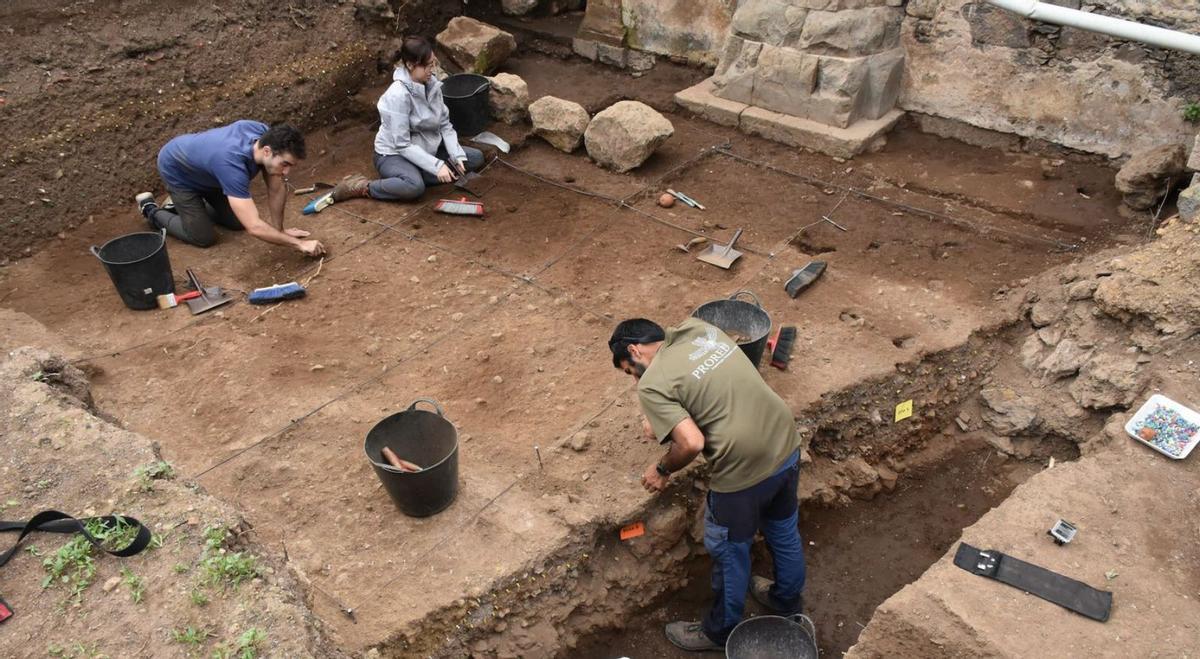The mystery of the San Lorenzo burials

The third archaeological excavation in the surroundings of the Church of San Francisco, in search of remains of the old convent of San Lorenzo de La Orotavaconcludes with the discovery of the skeletal remains of eight individuals in several graves associated with burials that took place in this religious place before it was destroyed by a fire in 1801. The field work, commissioned by the General Directorate of Culture and Heritage of the Canary Islands Government, in collaboration with the La Orotava City Council, has made it possible to document burials and unpublished daily objects that reveal new data on the functioning and evolution of the first monastic foundation of the Villa de La Orotava.
These findings, dated between the end of the 17th century and the beginning of the 18th century, reinforce the hypothesis that the interior of this type of ecclesiastical spaces was used as a burial place, advanced the Prored team, the company in charge of this project from 2021.
In addition to these findings, conservation work has been carried out on the architectural elements associated with this ancient convent founded in 1519, both a stone arch and an attached column with a Corinthian-style capital. The location of these elements, as explained by the excavation team, confirms previous statements that the area intervened corresponded to an interior nave of the convent.

The team of archaeologists unearths what remains of the old Franciscan convent of La Orotava. | ED
The founder Bartolomé Benítez
The church of San Francisco de La Orotava stands on the vestiges of the old convent of San Lorenzo, founded by Bartolomé Benítez de Lugo, nephew of the conqueror of Tenerife Alonso Fernández de Lugo, beginning of the 16th century (1519). In 1801, the convent was destroyed by a fire and then rebuilt with some elements of the original building, such as the entrance porch, the gallery elevation around the patio and the access staircase to the cloister.
For the general director of Culture and Cultural Heritage, Miguel Ángel Clavijo, this research is essential to “delve into the history of a convent that Viera y Clavijo called El Escorial de Canarias.” «This is a part of history that has been hidden and deserves to be recovered for its influence on the future not only of the Villa de La Orotava, but of the entire Archipelago because we must remember that this property was one of the first convents. Franciscans of the Canary Islands,” he declared during a visit to the enclave.
The mayor of La Orotava, Francisco Linares, assessed positively that these archaeological actions are carried out in the municipality since “they are investigations that allow us to discover part of the local history and get closer to the values of our heritage.
Regarding the anthropological study of the skeletal remains, of the eight individuals registered, three are adults and five are minors. In fact, this discovery is relevant because it shows that the convent was used for burials of people of different ages, in some cases reusing the graves of adults to deposit children’s remains, the archaeologists determined, a common funerary practice at the time.
In addition, objects related to the clothing, daily life and furniture of the people related to this enclave have been recovered, such as a coin, a pin, several buttons or a pipe, among other vestiges contextualized in the Old Regime.
On the other hand, the excavation has also made it possible to identify a stratigraphic package that includes other architectural elements such as stone blocks and brick remains, which are part of the original structures of this emblematic convent.
Key information
These structural elements, together with the human remains found, provide key information about the organization of the convent and the funerary practices that took place there. The in-depth analysis of the vestiges will continue in future phases of the campaign, as will the application of the restoration and conservation proposals.
In a previous excavation in 2022, archaeologists had already located bone remains in this ancient convent. On that occasion, remains of that chasnera slab, slate, brick, baked clay slab and also pieces typical of the way of life of this time such as hand-made ceramics were also found.




